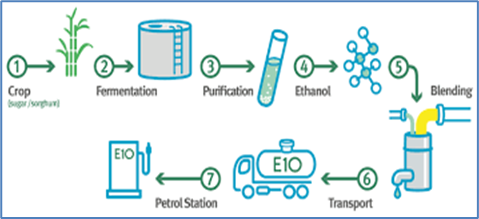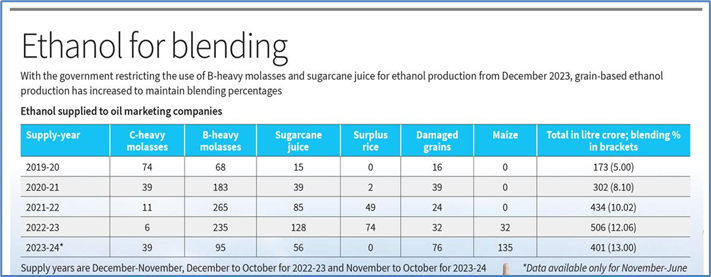Why in News?
India is on its way to achieve its target of blending 20% of petrol with ethanol by 2025-26. But concerns about fuel efficiency in existing vehicles and the food vs fuel debate still loom large over the ethanol economy.
What’s in Today’s Article?
- About Ethanol (C2H5OH)
- About the Ethanol Blended Petrol (EBP) Programme
- Status of Ethanol Production Capacity in India
- Challenges Hanging Over India's Ethanol Economy
- Way Ahead
About Ethanol (C2H5OH) and Ethanol Blending:

- Ethanol is an agricultural by-product which is mainly obtained from the processing of sugar from sugarcane, but also from other sources such as rice husk or maize.
- Since ethanol is produced from plants that harness the power of the sun, it is also considered as renewable fuel.
- In India, ethanol is mainly produced from sugarcane molasses by fermentation process.
- Ethanol is 99.9% pure alcohol that can be blended with petrol.
- To supplement ethanol supplies, the Government of India has permitted the procurement of ethanol produced from sources other than molasses, which is known as first generation ethanol or 1G.
- Aside from molasses, ethanol can be derived from rice straw, wheat straw, corn stover, bagasse, bamboo and woody biomass, which are known as second generation ethanol sources or 2G.
India’s Ethanol Blended Petrol (EBP) Programme:
- About:
- It was launched by the Ministry of Petroleum and Natural Gas in 2003 to promote the use of alternative and environment friendly fuels.
- This programme has been extended to the whole of India (except UTs of Andaman Nicobar and Lakshadweep islands) with effect from 1st April, 2019 wherein Oil Marketing Companies (OMCs) sell petrol blended with ethanol up to 10%.
- The all-India average blending of ethanol with petrol has risen from 1.6% in 2013-14 to 11.8% in 2022-23.
- India's goal is to grow this ratio to 20% by 2030, but when the NITI Aayog released the ethanol roadmap in 2021, that deadline was advanced to 2025.
- 20% by 2025-26 would mean producing some 1,000 crore litres of ethanol for blending with petrol.
- Benefits of EBP programme:
- It will reduce India’s import bill.
- It will reduce environmental pollution.
- It will increase farm income.
- Biofuels demand least incremental investment for manufacturers.
- Challenges when it comes to 20% ethanol blended fuel:
- Engines would need to be tweaked so as to process petrol which has been blended with 20% ethanol.
- Ethanol burns completely emitting nil CO2. However, it does not reduce the emission of another key pollutant - nitrous oxide.
- Another source of contention is inefficient land usage in ethanol production and the amount of water required to cultivate crops for ethanol.
- Food security concerns, given the uncertainties surrounding future output.
Status of Ethanol Production Capacity in India:

- The Niti Aayog’s roadmap had laid down that
- The capacity of sugarcane-based distilleries would need to increase from 426 crore litres in 2021 to 760 crore litres in 2026.
- While grain-based distilleries’ capacity should increase from 258 to 740 crore litres.
- Two interest subvention programmes for establishing new distilleries had facilitated the ramping up of ethanol generation capacity.
Challenges Hanging Over India's Ethanol Economy:
- Fuel vs. food debate:
- In India, all the emphasis has been on first generation (1G) ethanol that is directly made from foodgrains and sugarcane.
- For example, sugarcane gives rise to three main related products - sugarcane juice and syrup, B-heavy molasses and C-heavy molasses, in the order of decreasing sugar content.
- The first two would typically go to making sugar while the third will be used for ethanol production.
- In a bid to up fuel ethanol production, the government had started permitting the diversion of the first two away from sugar production to fuel ethanol.
- Concerns about agricultural sustainability: Expanding sugarcane cultivation would redirect irrigation water from essential food-grain crops, exacerbating concerns about agricultural sustainability.
- Rising import bill:
- India ranks as a major maize producer globally, but domestic consumption consistently outpaces production.
- This is also because maize has been used to produce more fuel ethanol to compensate for restrictions on using sugarcane products.
- As a result, maize import has increased (from April to June 2024, the import is already worth $103 million) compared to last year.
- More cultivation area to meet the 20% target: As per NITI Aayog’s estimates, some 4.8 million hectares will have to be added to maize cultivation area to meet the 20% target, which is almost half of the typical maize cultivation area.
- Fuel efficiency in existing vehicles: The NITI Aayog report notes that ethanol brought down fuel efficiency in vehicles not suited for ethanol by an average of 6%.
- Performance across states:
- While the fuel ethanol pricing is the same across India, States determine the pricing of Extra Neutral Alcohol (ENA) that goes into making liquor for consumption and other uses.
- In UP, the government is fully aligned with the central government’s mission on ethanol and reserves ~25% of the ethanol for ENA.
- In Tamil Nadu, where liquor is a highly lucrative market for distilleries, fuel ethanol has not yet caught on as much.
Way Ahead:
- The government should diversify and move to 2G and 3G ethanol that have less adverse effect on India’s food security.
- Existing vehicles may have to go for an engine retuning and change over to E20 supported material.
- As liquor revenue forms a large chunk of revenue of most state governments, many across the industry demand an increase in ethanol pricing.









